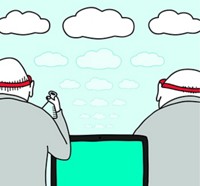Advertisement
Grab your lab coat. Let's get started
Welcome!
Welcome!
Create an account below to get 6 C&EN articles per month, receive newsletters and more - all free.
It seems this is your first time logging in online. Please enter the following information to continue.
As an ACS member you automatically get access to this site. All we need is few more details to create your reading experience.
Not you? Sign in with a different account.
Not you? Sign in with a different account.
ERROR 1
ERROR 1
ERROR 2
ERROR 2
ERROR 2
ERROR 2
ERROR 2
Password and Confirm password must match.
If you have an ACS member number, please enter it here so we can link this account to your membership. (optional)
ERROR 2
ACS values your privacy. By submitting your information, you are gaining access to C&EN and subscribing to our weekly newsletter. We use the information you provide to make your reading experience better, and we will never sell your data to third party members.
Policy
Seeing The Forest At Pfizer
A radical knowledge-sharing initiative takes hold at the world's largest drugmaker
by Rick Mullin
September 3, 2007
| A version of this story appeared in
Volume 85, Issue 36
Researchers tend to plant themselves in one place and sink their roots down deep. This certainly is the case in the pharmaceutical industry, where hundreds of project teams and individual researchers plumb the scientific depths of particular oncogenes or receptors to the point where they end up giving talks at drug discovery conferences with titles such as "Development of Selective Inhibitors of Aurora A Kinase: MLN8054 and MLN8237."
This tight focus in research has always posed a problem for those seeking a view of the forest as opposed to the up-close perusal of trees-a problem compounded over the past decade by the explosion of data in the lab. But the likelihood that valuable knowledge can be gleaned from all that raw information has also given researchers an incentive to attain broader know-how that might help them in their particular focused endeavor. Researchers are, in fact, so interested in getting information that they are showing an increased willingness to share their own knowledge as part of the bargain.
Developing an information technology (IT) venue that provides access to a company's full complement of information and knowledge while maintaining control of intellectual property has become one of the biggest problems in drug discovery and development today. Blogs have limitations. They are generally known only to small communities within a company, tend to serve only those communities, and are difficult to "police." Top-down approaches, such as corporate knowledge management systems, tend to illustrate the difficulties in getting all parts of a large organization on the same screen regarding IT, especially when that organization is populated by scientists with very parochial IT needs.
A computational biologist at Pfizer's Research Technology Center (RTC) in Cambridge, Mass., on the other hand, recently demonstrated that a bottom-up approach can work at the push of a button and at no cost.
Christopher Bouton, computational biology group leader at RTC, approaches drug research with a decided preference for the forest-level view. "I really like to work with system-level views of ideas," he told me, explaining why he gravitated toward computation approaches after getting a Ph.D. in neurobiology. "It's harder to get that view when you're working at the bench, with test tubes and that kind of stuff." This bent, in turn, got him involved in "knowledge engineering," the development of shared research tools at Pfizer.
Frustrated with the difficulty he had in getting at information dispersed throughout the world's largest drug company, Bouton decided to launch his own knowledge repository using a popular Internet tool. "Basically what I did," he says, "was download MediaWiki, the open-source software that runs Wikipedia, onto a computer under my desk and press the on button."
Bouton envisioned launching a scientific encyclopedia within Pfizer's IT firewall as a resource for himself and others. Step one: Pre-populate the site with all the scientific articles on Wikipedia, the ubiquitous Internet encyclopedia running on a collaborative Internet worksite called a wiki. This proved an unworkably large task. Bouton decided instead to post some internal Pfizer content, "turn it on, and see what happens."
What happened was that the wiki spread through Pfizer like a virus, filling voids, connecting dots, and attaining its own form-that of a high-level road map to research going on across the company, studded with hypertext links to detailed research. One year after its launch at the beginning of 2006, the wiki was receiving 12,000 hits per month by 13,000 individual users across Pfizer worldwide. People began calling it Pfizerpedia.
Pfizer's surprisingly liberal attitude toward individual efforts at fostering collaboration on the Internet created an environment in which Pfizerpedia could thrive or shrivel without management interference. It thrived. The wiki proved the perfect tool for IT-savvy, text-messaging researchers, who revealed a pent-up need to share information. It took shape in the same evolutionary milieu in which Web technologies fail utterly or succeed wildly-the user community.
Wikis in general illustrate the powerful ethos of a community in which members correct each others' errors, lock out troublemakers, and tend, on an individual level, to work for the good of the group. While Pfizerpedia has "curators" who administer the site and remove inappropriate entries, "a very minimal amount of that work is done," Bouton says. "It just isn't needed."
According to Bouton, the wiki approach affords a much more comprehensive view than blogs or discussion groups, which he cites as the two other important Web technologies that can assist researchers. Pfizerpedia can actually serve as a guide to relevant blogs or discussion groups within Pfizer, he says.
As an intra-Pfizer Web tool, Pfizerpedia appeals to researchers not only as a way to get information, but also as a means of promoting personal or team projects, Bouton says. Mostly, however, the success of the wiki has shown that there is, despite popular conceptions, a radical, root-level interest among researchers in sharing information. Emanating at the subterranean part of the forest where the separation among individual research trees is not so apparent, this interest runs straight up to the canopy.
Giles Day, a senior director of target and mechanism informatics at Pfizer, would attest to the importance of easy-to-use technologies emerging on the Web. "To a certain extent," says Day, a Pfizerpedia enthusiast, "we are standing at the brink of a new age of technology-enabled collaboration."
Views expressed on this page are those of the author and not necessarily those of ACS.






Join the conversation
Contact the reporter
Submit a Letter to the Editor for publication
Engage with us on Twitter